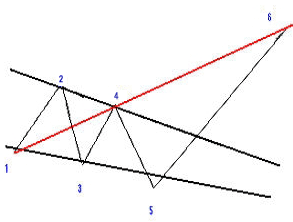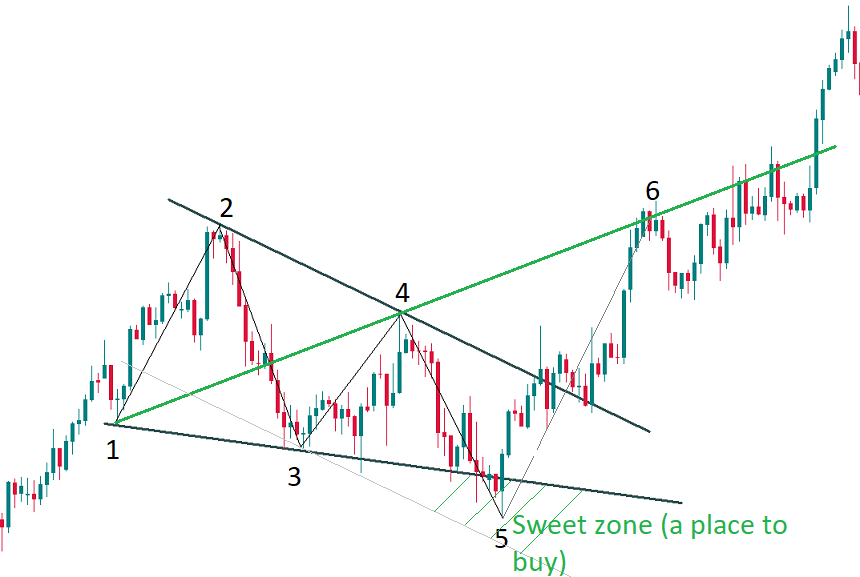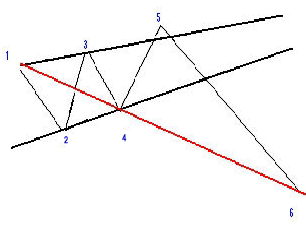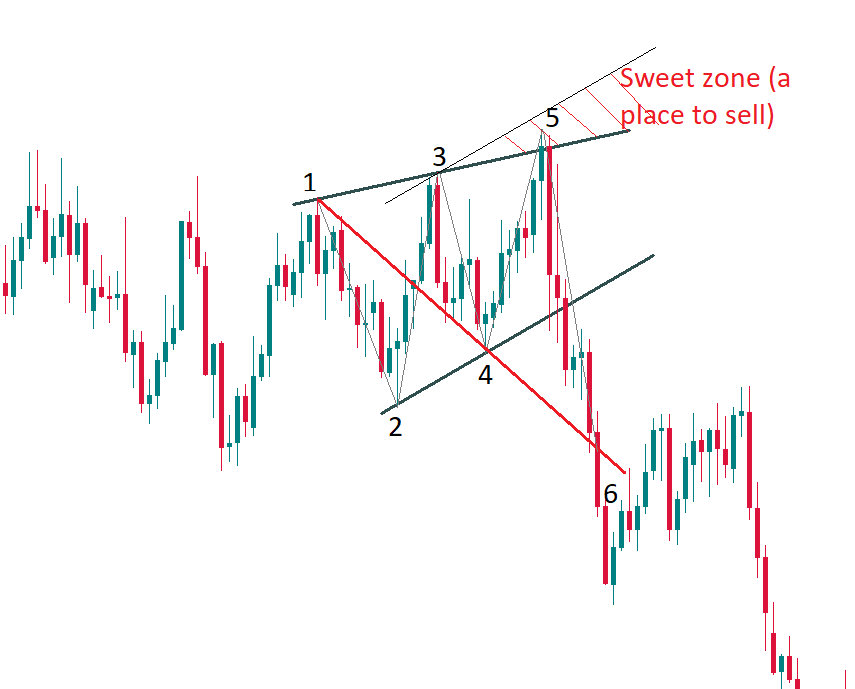It’s time to upgrade your knowledge about the market even further by learning how to recognize a Wolfe waves pattern. This is an advanced chart pattern for experienced traders.
The idea that the market moves in a series of waves was developed by Ralph Nelson Elliott. Bill Wolfe proposed his own view on waves in technical analysis. The price in a Wolfe waves pattern is swinging like a pendulum trying to find equilibrium. Wolfe discovered a reversal pattern, so after trading within a channel during 4 waves, the price makes a breakout (leaves the channel) in the fifth wave.
You'll be pleased to know that a Wolfe waves pattern can be found on any time frame and at the chart of any financial instrument.
Bullish Wolfe waves pattern
There’s a very strict set of rules that define this pattern. Let's study a bullish Wolfe waves pattern first.

Here are its key parameters of bullish wolf pattern:
- Wave 1-2 is the base of the pattern and is bullish.
- Point 2 should be higher than point 1, while point 3 should be below point 1.
- Wave 3-4 should stay within the channel created by the wave 1-2. Waves 1-2 and 2-3 should be equal (symmetric). Point 3 is usually at the 127.2% or 161.8% extensions of the wave 1-2. Point 4 should be below point 2 and above point 3.
- Point 5 is the low set after the 3-4 wave. It’s located close to the line drawn through the points 1 and 3. Point 5 is usually at the 127.2% or 161.8% extensions of the wave 3-4.
- Point 6 lies at the line drawn from point 1 through point 4. Wave 5-6 is the longest wave of the pattern. Points 1, 4, and 6 lie at the one line.
How to trade
The idea of trading the bullish Wolfe waves pattern is to buy at the point 5. Take Profit order should be located at the point 6.
The point 5 can be at or below the 1-3 line. In this case, draw an auxiliary line through the points 2 and 4 and move this line in parallel to the point 3. The space between the line 1-3 and the projection of the line 2-4 from point 3 is called a "sweet zone". This is the are where you should look for the opportunity to buy. If the 2-4 line is parallel to the 1-3 line, then there’s no sweet zone. If the angle between the lines 1-3 and the projection of the line 2-4 is too, there’s a mistake and it’s not a Wolfe waves pattern. Check the example of a bullish Wolfe waves pattern in MetaTrader:

Bearish Wolfe waves pattern
Now let's examine a bearish Wolfe waves pattern.

Here are its key parameters of bearish wolf pattern:
- Wave 1-2 is the base of the pattern and is bearish.
- Point 2 should be lower than point 1, while point 3 should be above point 1.
- Wave 3-4 should stay within the channel created by the wave 1-2. Waves 1-2 and 2-3 should be equal (symmetric). Point 3 is usually at the 127.2% or 161.8% extensions of the wave 1-2. Point 4 should be above point 2 and below point 3.
- Point 5 is the high set after the wave 3-4. It’s located close to the line drawn through the points 1 and 3. Point 5 is usually at the 127.2% or 161.8% extensions of the wave 3-4.
- Point 6 lies at the line drawn from point 1 through point 4. Wave 5-6 is the longest wave of the pattern. Points 1, 4, and 6 lie at the one line.
How to trade
Like the mirror of a bullish Wolfe waves pattern, the idea of trading the bearish Wolfe waves pattern is to sell at the point 5 (in the "sweet zone" for selling formed by drawing a line parallel to the line 2-4 from point 3). Take Profit order should be located at the point 6. Here's how such trade looks on a real chart:
Conclusion
To find a Wolfe waves pattern on the chart, look for 3 points that lie at about one line. Check for points 2 and 4 nearby and see whether it all fits the description of a bullish or bearish pattern.
We recommend trading Wolfe waves patterns for those who already have some Forex trading experience because it's not easy to recognize these setups on the charts. However, once recognized, the pattern generates a signal that offers a very high probability of successful trade, so if you master it, you'll have some spectacular trades.



0 commentaires:
Enregistrer un commentaire